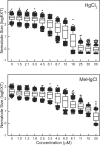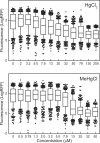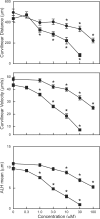Comparative toxicology of mercurials in Caenorhabditis elegans
- PMID: 21692103
- PMCID: PMC3152674
- DOI: 10.1002/etc.603
Comparative toxicology of mercurials in Caenorhabditis elegans
Abstract
Mercury (Hg) is a toxic metal that can exist in multiple chemical species. Humans are commonly exposed to methylmercury and Hg vapor, which are converted to mercuric species in the body. Despite years of research, little information exists on the similarities and differences in the mechanisms of Hg toxicity. The relative toxicity of mercuric chloride (HgCl(2)) and methylmercury chloride (MeHgCl) in Caenorhabditis elegans was determined in assays that measured growth, feeding, reproduction, and locomotion. The effect of HgCl(2) and MeHgCl on the expression of several archetypal stress-response genes was also determined. There was no significant difference between the EC50s of the two mercurials in terms of C. elegans growth. However, MeHgCl was more toxic to C. elegans than HgCl(2) when assessing feeding, movement, and reproduction, all of which require proper neuromuscular activity. Methylmercury chloride exposure resulted in increased steady-state levels of the stress response genes at lower concentrations than HgCl(2). In general, MeHgCl was more toxic to C. elegans than HgCl(2), particularly when assaying behaviors that require neuromuscular function.
Copyright © 2011 SETAC.
Figures





Similar articles
-
Comparative toxicogenomic responses of mercuric and methyl-mercury.BMC Genomics. 2013 Oct 11;14:698. doi: 10.1186/1471-2164-14-698. BMC Genomics. 2013. PMID: 24118919 Free PMC article.
-
Characterization of the effects of methylmercury on Caenorhabditis elegans.Toxicol Appl Pharmacol. 2009 Oct 15;240(2):265-72. doi: 10.1016/j.taap.2009.03.013. Epub 2009 Mar 31. Toxicol Appl Pharmacol. 2009. PMID: 19341752 Free PMC article.
-
Methylmercury speciation influences brain gene expression and behavior in gestationally-exposed mice pups.Toxicol Sci. 2009 Aug;110(2):389-400. doi: 10.1093/toxsci/kfp105. Epub 2009 May 22. Toxicol Sci. 2009. PMID: 19465457
-
Hormetic effect of methylmercury on Caenorhabditis elegans.Toxicol Appl Pharmacol. 2010 Oct 15;248(2):156-64. doi: 10.1016/j.taap.2010.07.023. Epub 2010 Aug 5. Toxicol Appl Pharmacol. 2010. PMID: 20691719 Free PMC article.
-
Association of oxidative stress with the formation of reproductive toxicity from mercury exposure on hermaphrodite nematode Caenorhabditis elegans.Environ Toxicol Pharmacol. 2011 Sep;32(2):175-84. doi: 10.1016/j.etap.2011.04.009. Epub 2011 May 5. Environ Toxicol Pharmacol. 2011. PMID: 21843797
Cited by
-
C. elegans as a model in developmental neurotoxicology.Toxicol Appl Pharmacol. 2018 Sep 1;354:126-135. doi: 10.1016/j.taap.2018.03.016. Epub 2018 Mar 14. Toxicol Appl Pharmacol. 2018. PMID: 29550512 Free PMC article. Review.
-
Genetic factors in methylmercury-induced neurotoxicity: What have we learned from Caenorhabditis elegans models?Adv Neurotoxicol. 2023;9:271-290. doi: 10.1016/bs.ant.2023.01.006. Epub 2023 Mar 13. Adv Neurotoxicol. 2023. PMID: 37389202 Free PMC article. No abstract available.
-
Molecular basis for antioxidant enzymes in mediating copper detoxification in the nematode Caenorhabditis elegans.PLoS One. 2014 Sep 22;9(9):e107685. doi: 10.1371/journal.pone.0107685. eCollection 2014. PLoS One. 2014. PMID: 25243607 Free PMC article.
-
Applications of a powerful model organism Caenorhabditis elegans to study the neurotoxicity induced by heavy metals and pesticides.Physiol Res. 2023 Apr 30;72(2):149-166. doi: 10.33549/physiolres.934977. Physiol Res. 2023. PMID: 37159850 Free PMC article.
-
Antagonistic Growth Effects of Mercury and Selenium in Caenorhabditis elegans Are Chemical-Species-Dependent and Do Not Depend on Internal Hg/Se Ratios.Environ Sci Technol. 2016 Mar 15;50(6):3256-64. doi: 10.1021/acs.est.5b06044. Epub 2016 Mar 3. Environ Sci Technol. 2016. PMID: 26938845 Free PMC article.
References
-
- Pacyna EG, Pacyna JM, Steenhuisen F, Wilson S. Global anthropogenic mercury emission inventory for 2000. Atmos Environ. 2006;40:4048–4063.
-
- Streets DG, Zhang Q, Wu Y. Projections of global mercury emissions in 2050. Environ Sci Technol. 2009;43:2983–2988. - PubMed
-
- Lin CJ, Pehkonen SO. The chemistry of atmospheric mercury: A review. Atmos Environ. 1999;33:2067–2079.
-
- Ullrich SM, Tanton TW, Abdrashitova SA. Mercury in the aquatic environment: A review of factors affecting methylation. Crit Rev Environ Sci Technol. 2001;31:241–293.
-
- Downs SG, Macleod CL, Lester JN. Mercury in precipitation and its relation to bioaccumulation in fish: A literature review. Water Air Soil Pollut. 1998;108:149–187.
Publication types
MeSH terms
Substances
Grants and funding
LinkOut - more resources
Full Text Sources

